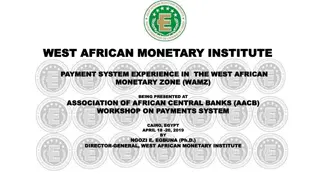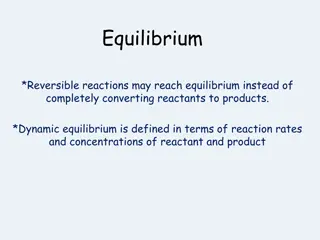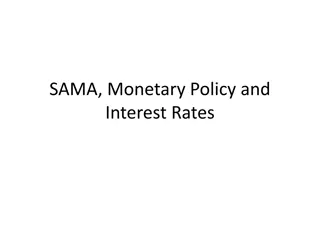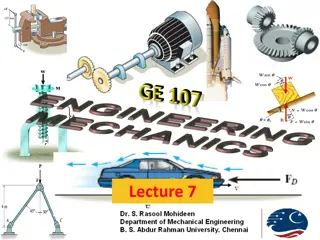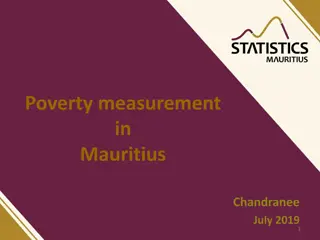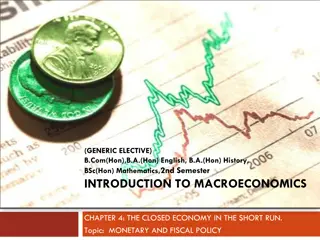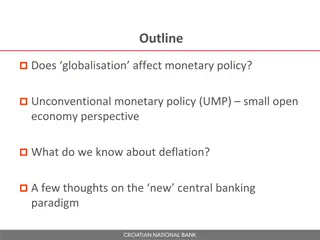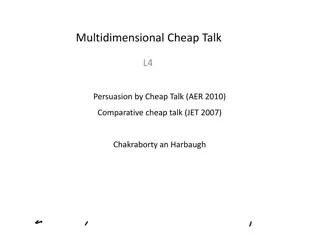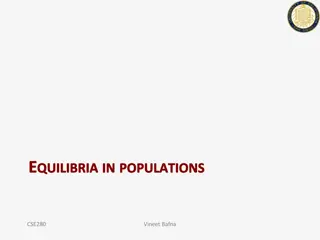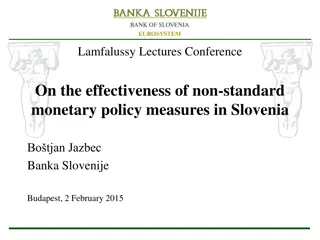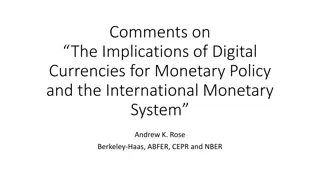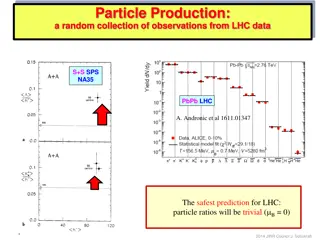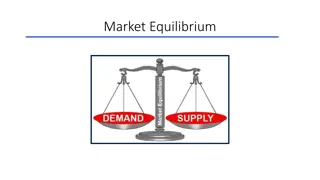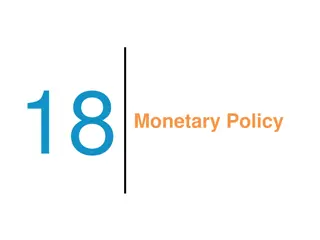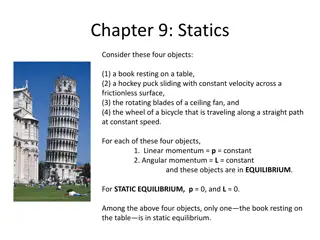Overview of Monetary Aggregates in Bosnia and Herzegovina
Image descriptions and explanations about monetary aggregates, money as a payment instrument, cash in circulation, deposit money, M1, M2, M3 categories, and monetary base. Additionally, details on net foreign assets, net reserves, and changes in monetary policy affecting currency board arrangements
1 views • 17 slides
Development of West African Monetary Institute Payment System
The West African Monetary Institute (WAMI) has been instrumental in establishing a payment and settlement system within the West African Monetary Zone (WAMZ). The institute's efforts have focused on promoting cross-border transactions and economic integration among member countries, with the ultimat
0 views • 46 slides
Equilibrium for Moving Objects
Objects can be in static equilibrium when at rest or dynamic equilibrium when moving at a constant speed. Equilibrium is maintained when there is no net force to change the state of motion. This equilibrium is possible when forces either cancel out or there is no force acting on the object. Friction
1 views • 8 slides
Chemical Equilibrium in Reversible Reactions and Laws
Chemical equilibrium in reversible reactions involves the balance between forward and backward reactions, as governed by laws like the law of mass action and the law of chemical equilibrium. These laws help in understanding the rates of reactions, equilibrium constants, and the relationship between
2 views • 12 slides
Dynamic Equilibrium in Chemical Reactions
Explanation of reversible reactions, dynamic equilibrium, and the characteristics of equilibrium in chemical systems. Covers the concept of reversible reactions, dynamic equilibrium, rules for dynamic equilibrium, and examples to illustrate these concepts visually.
0 views • 54 slides
Le Chatelier's Principle in Chemical Equilibrium
Le Chatelier's Principle states that when a system at equilibrium is disturbed by changes in concentration, temperature, or pressure, the equilibrium shifts to counteract the change. This principle can be applied to predict the direction of equilibrium when changes occur. Changes in concentration, p
0 views • 10 slides
Reaction Isotherms and Equilibrium Constants
Explore reaction isotherms and equilibrium constants through Vant Hoff's and Gibbs free energy equations. Learn about the relationship between Gibbs free energy, equilibrium constant, and temperature dependence. Discover how these concepts are applied in determining the direction of chemical reactio
3 views • 18 slides
Saudi Arabian Monetary Agency (SAMA) Overview
The Saudi Arabian Monetary Agency (SAMA) serves as the central bank of Saudi Arabia with a focus on managing the country's monetary policy, maintaining price stability, and supervising financial institutions. Established in 1952, SAMA's functions include managing the national currency, foreign excha
0 views • 24 slides
Equilibrium of Rigid Bodies: Moments, Couples, and Forces
The topic covers the equilibrium of rigid bodies with a focus on moments, couples, and forces. It discusses concepts such as moments of a force, Varignon's theorem, types of supports, and equilibrium in two and three dimensions. The equilibrium in two-force members and three-force members is explain
1 views • 23 slides
Poverty Measurement in Mauritius: An Overview of Monetary and Non-Monetary Approaches
The measurement of poverty in Mauritius involves multidimensional assessments using both monetary and non-monetary approaches. The country's national priorities include poverty eradication, improving well-being, and ensuring inclusive growth. The monetary approach assesses poverty based on the Relat
1 views • 12 slides
Macroeconomic Policy Tools: Monetary and Fiscal Policy in Short Run
This chapter delves into the IS-LM model to illustrate the functioning of monetary and fiscal policies in influencing economic growth. It explains how these policies impact output, interest rates, and inflation rates in a closed economy in the short run. Monetary policy mainly operates through open
0 views • 18 slides
Small Countries' Resilience Against Center-Country Monetary Policies
Small countries should not fear the monetary and financial policies of larger center countries. This article discusses the potential spillovers of unconventional monetary policies by center countries, such as quantitative easing and negative nominal interest rates. It explores the concept of currenc
2 views • 39 slides
Consumer Equilibrium in Economics
Consumer equilibrium refers to the point where a consumer maximizes satisfaction by spending income on commodities. In single commodity case, equilibrium is achieved when marginal utility equals price. For two commodities, equilibrium is reached when the ratio of marginal utility to price is equal.
1 views • 7 slides
Globalisation's Impact on Monetary Policy and Central Banking Paradigm
Globalisation has reshaped monetary policy dynamics, influencing inflation pressures and the transmission of shocks across economies. Unconventional monetary policies in small open economies have challenged conventional theories, highlighting the complexity of managing monetary conditions. The inter
0 views • 24 slides
Free Energy, Reaction Quotient, and Equilibrium Constant
This educational material delves into the concepts of free energy, reaction quotients, and equilibrium constants in chemical systems. It explains how to determine the direction of a reaction based on Q and K values, elucidates the role of Gibbs free energy in determining spontaneity, and provides ca
0 views • 10 slides
Chemical Equilibrium in Reversible Reactions
Chemical equilibrium occurs when the concentrations of reactants and products remain constant over time in a reversible reaction. Reaction rate is proportional to concentration, and equilibrium is reached when the rate of formation equals the rate of consumption in both directions. Reversible reacti
2 views • 25 slides
Insights into Persuasion and Equilibrium in Multidimensional Cheap Talk
Explore the dynamics of multidimensional cheap talk, focusing on sender-receiver interactions, influential equilibrium, welfare rankings, and fragility to asymmetries. Lessons touch on bubbling equilibrium, influential equilibrium issues, welfare rankings preferences, and the impact of asymmetric pr
1 views • 20 slides
Equilibria in Populations: Hardy-Weinberg Principle
Exploring the concept of equilibria in populations, focusing on Hardy-Weinberg principles and its implications. The discussion covers allele distributions, genotype frequencies, maintenance of equilibrium across generations, and scenarios where equilibrium may be violated. Key points include basic p
0 views • 58 slides
Challenges and Solutions in Implementing Non-Standard Monetary Policies in Slovenia
The decoupling of real and financial cycles in Slovenia, attributed to a balance-sheet recession and unsustainable debt-financed growth, poses challenges for monetary policy effectiveness. Credit decline persists despite economic growth, hindered by risk-averse banks and limited market for alternati
1 views • 14 slides
Groundwater Sustainability and Equilibrium Dynamics
This content delves into the concepts of groundwater sustainability, equilibrium, and capture in relation to groundwater management. It explores transitional storage, groundwater mining, and debunks the water budget myth. The images and explanations illustrate how pumping affects aquifers, the evolu
1 views • 11 slides
Insights on Digital Currencies: Implications for Monetary Policy and the International System
Reflecting on the implications of digital currencies for monetary policy and the international monetary system, the comments by Andrew K. Rose highlight potential effects on capital mobility, currency substitution, and the evolution of money. Emphasizing the small size of cryptocurrencies compared t
0 views • 18 slides
Insights into Particle Ratios and Equilibrium Dynamics at LHC
Collection of observations from LHC data regarding particle ratios and the successful Thermal Model. Discusses the concept of equilibrium, onset of equilibrium, relationship to QGP phase, and potential solutions through out-of-equilibrium studies. Also delves into size/volume dependence, strangeness
1 views • 11 slides
Homogenous Chemical Equilibrium
Homogenous chemical equilibrium occurs when reactants and products are in the same phase. This equilibrium remains independent of the volume of the reaction mixture. The concept is illustrated through the example of the Hydrogen-Iodide system and a generic reaction A + B --> 2C. Partial pressure pla
1 views • 56 slides
Insights into Non-equilibrium Kinetic Theory: Inhomogeneous Systems
Statistical averages in kinetic theory connect distribution functions to macroscopic properties like pressure and particle flux. When systems are inhomogeneous or away from equilibrium, local equilibrium breaks down, leading to slow relaxation processes towards global equilibrium. The evolution of p
0 views • 12 slides
The Emergence of Monetary Stability in a Changing Economic Landscape
Amidst global economic shifts, A.I.G. Rose and A.K. Rose explore the emergence of monetary stability in their publication "A Presence of Absence." They delve into the rise of effective monetary policies, the impact of inflation targeting, and the evolution of stable monetary regimes. Through insight
0 views • 36 slides
Equilibriums in Physics
Equilibrium in physics refers to the state of a body where there is no change in translational or rotational motion. This state can be classified into static equilibrium (when total force and torque are zero) and dynamic equilibrium (when a body is in uniform motion with zero resultant force and tor
1 views • 9 slides
Market Equilibrium
Market equilibrium is achieved when the quantity demanded equals the quantity supplied at a specific price, ensuring a balance in the marketplace. Demand and supply schedules play a crucial role in determining market equilibrium, with excess supply or demand occurring when prices deviate from the eq
0 views • 12 slides
Game Abstraction and Equilibrium
Extensive-Form Game Abstraction with Bounds delves into the complexities of game abstraction, exploring theoretical guarantees, algorithmic challenges, and equilibrium-finding processes. The difficulty of game abstraction is examined, highlighting issues such as pathologies and the struggle to optim
1 views • 22 slides
Chemical Equilibrium in Chemistry
Exploring the concept of chemical equilibrium in chemistry, where reactions can occur in both forward and reverse directions to an appreciable extent. Learn about basic equilibrium principles, equilibrium problems, manipulating reactions, and common example problems in nomenclature. Understand how r
0 views • 24 slides
Operating high sensitivity measurement apparata out of equilibrium
Operating high sensitivity measurement apparata out of equilibrium presents challenges and opportunities in gravitational wave science and technology. This includes the exploration of equilibrium versus out-of-equilibrium conditions, previous attempts using external feedback, and an analysis of line
0 views • 16 slides
Friction and Equilibrium in Physics
Concepts of friction and equilibrium in physics, including definitions of forces like weight, tension, and reaction force. Learn about the relationship between friction force and reaction force, solving equilibrium problems, and the significance of limiting equilibrium. Find practical examples and c
0 views • 19 slides
Germany's First Common Currency: A Historical Analysis
Germany's first common currency in 1559 is examined in this research, scrutinizing its success, impact on monetary stability, and comparison to other currencies of the time. Economic and monetary historians present varying perspectives on the effectiveness of the Imperial Monetary Union. Factors inf
1 views • 16 slides
Monetary Policy Uncertainty Effects Analysis
This discussion explores the impact of monetary policy uncertainty on the effectiveness of monetary policy surprises, with a focus on term premium effects and comparison to related studies. The distinction between funds rate and forward guidance policies is also highlighted, along with their interac
0 views • 9 slides
Role of U.S. Monetary Policy in Global Banking Crises
The paper explores how U.S. monetary policy affects global financial stability and the probability of banking crises in different countries. It analyzes data from 69 countries between 1870 and 2010, highlighting the impact of U.S. monetary tightening on countries with direct links to the U.S. versus
0 views • 17 slides
Understanding Chemical Equilibrium in Chemistry Lectures
In these Chemistry lecture announcements, you will find information about exam coverage, lab data postings, calibration questions, and manipulating equilibrium reaction equations. The content covers topics such as statistical calculations, least squares regression, equilibrium equations from chemica
0 views • 19 slides
Saudi Arabian Monetary Agency (SAMA) Functions and Monetary Policy Overview
Learn about the Saudi Arabian Monetary Agency (SAMA), the central bank of Saudi Arabia established in 1952. Explore the functions of SAMA, including managing monetary policy, supervising financial institutions, and maintaining the stability of prices and exchange rates. Discover the balance sheet of
0 views • 24 slides
Understanding Monetary Policy and Equilibrium Rates in Brazil
Delve into the world of monetary policy and equilibrium rates in Brazil, focusing on the stabilization of inflation, real interest rates, and the impacts of the Real plan. Learn about recent research findings and the relationship between effective rates, equilibrium rates, and the Taylor rule. Explo
0 views • 12 slides
Tax Incidence and General Equilibrium Analysis
Explore the concept of tax incidence in a general equilibrium framework, focusing on tracing taxes back to the original owners of factors such as producers, consumers, capital owners, labor, and landlords. The analysis covers partial equilibrium and general equilibrium models, including static and d
0 views • 21 slides
Understanding Monetary Policy and Its Short-Run Effects
Explore the intricacies of monetary policy, its impact on the economy in the short run, and why it doesn't always work as intended. Discover key concepts like the Phillips curve, short run vs. long run effects, and examples of expansionary monetary policy in action. Gain insights into how central ba
0 views • 43 slides
Equilibrium Conditions and Applications in Physics
Learn about static equilibrium, equilibrium requirements, equations for equilibrium, and how to apply equilibrium conditions to rigid bodies in physics. Explore examples and problems related to static equilibrium and forces in various objects.
0 views • 9 slides

